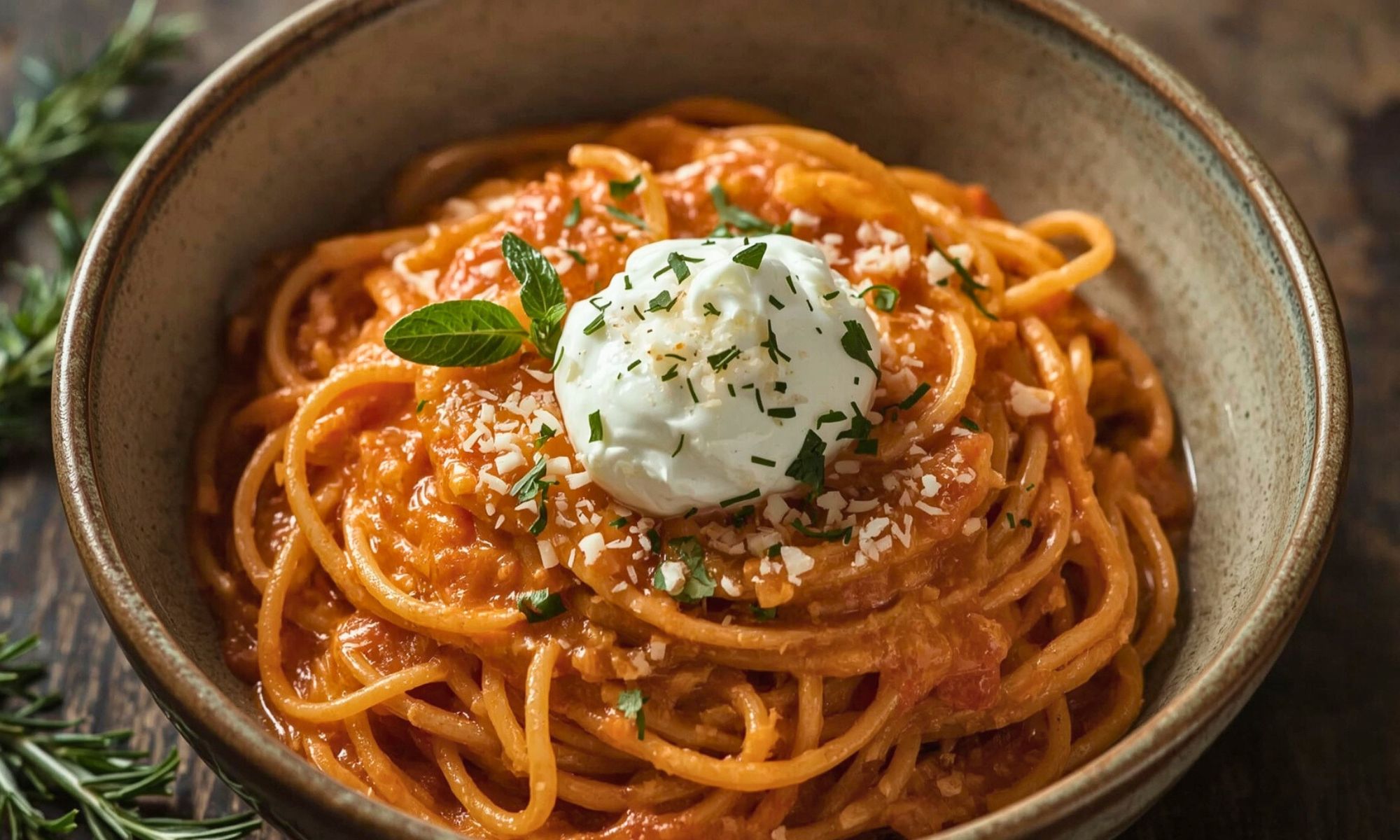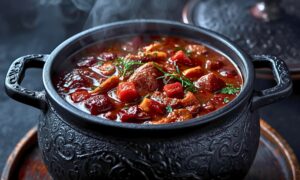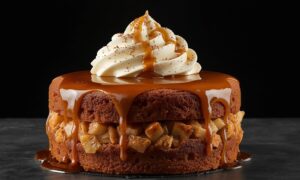Forget everything you think you know about weeknight pasta. While everyone else drowns their noodles in predictable marinara, you’re about to master something that transforms humble red peppers into liquid silk. This isn’t another “throw sauce on pasta” recipe, it’s your ticket to restaurant level sophistication that happens to take thirty minutes.
I stumbled onto this Creamy Red Pepper Pasta with Burrata and Herbs during one of those nights when my fridge looked pathetic but my cravings ran high. That lonely jar of roasted peppers? Pure gold waiting to happen. The burrata I’d been saving for “something special”? Tonight was that night.
What makes this Creamy Red Pepper Pasta with Burrata and Herbs different isn’t just the gorgeous coral color or the way that first bite makes you close your eyes. It’s how this dish proves that extraordinary flavors come from understanding your ingredients, not from complicated techniques or fancy equipment.
The roasted peppers bring sweet, smoky depth. Heavy cream creates that luxurious texture without weighing you down. Fresh burrata melts into creamy pockets throughout every bite.
Herbs add brightness that keeps things interesting instead of heavy.
This recipe delivers restaurant elegance using grocery store ingredients. No special training required, no exotic shopping trips necessary.
Essential Ingredients for Perfect Creamy Red Pepper Pasta with Burrata and Herbs
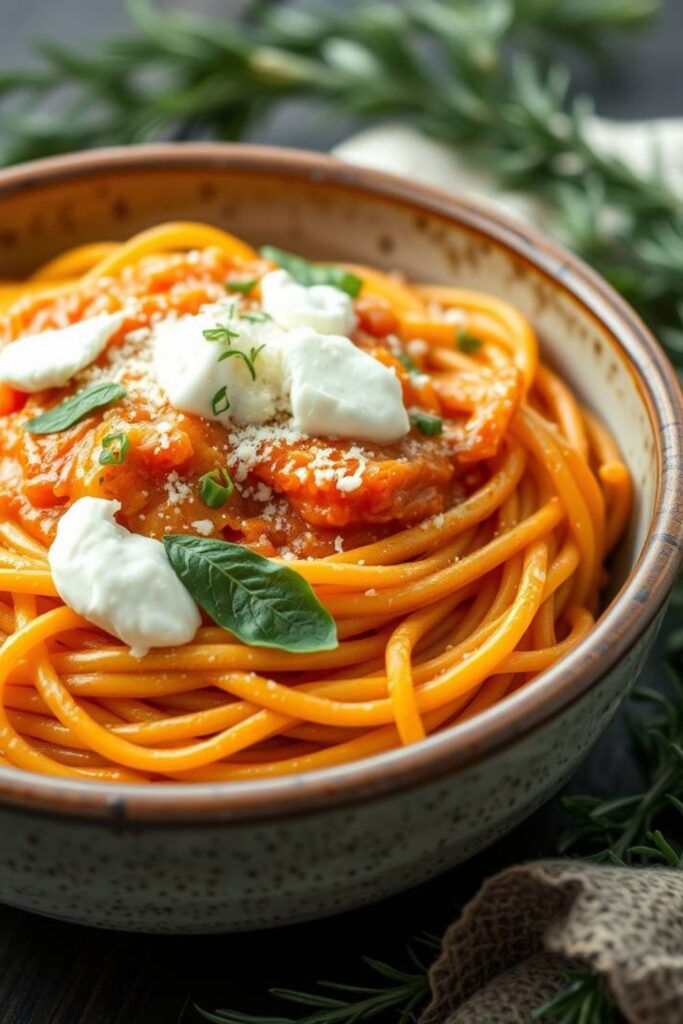
Your Shopping List (In Cooking Order)
Here’s what you’re gonna grab, listed exactly how you’ll use them:
- 1 pound rigatoni or penne pasta
- 1 jar (12 oz) roasted red peppers, drained
- 4 garlic cloves, minced
- 3 tablespoons quality olive oil
- 1/2 cup heavy cream
- 1/2 cup fresh Parmesan, grated
- 8 oz burrata cheese, torn into chunks
- 1/4 cup fresh basil, roughly chopped
- 2 tablespoons fresh oregano (or 1 tablespoon dried)
- Salt and black pepper to taste
- Red pepper flakes (optional but recommended)
- 1/2 cup reserved pasta water
Smart Ingredient Swaps That Actually Work
Life happens. Ingredients disappear.
Here’s how to adapt without compromising flavor.
Can’t find burrata? Fresh mozzarella works when torn into irregular pieces. The texture differs slightly, but that creamy contrast remains. Ricotta dolloped throughout creates tangy richness that’s equally satisfying.
Heavy cream feeling too indulgent? Half and half plus one tablespoon cream cheese maintains richness. For lighter versions, stir Greek yogurt into cooled pasta, it adds tangy creaminess without breaking.
Those jarred roasted peppers are convenient, but fresh red bells charred over open flame create deeper flavor. Blacken the skin completely, steam in covered bowl for ten minutes, then peel. Don’t rinse, you’ll wash away precious flavor compounds.
Fresh herbs matter here. Dried oregano substitutes adequately, but fresh basil stays non negotiable.
That bright, peppery bite can’t be replicated with dried alternatives.
Step by Step Creamy Red Pepper Pasta with Burrata Mastery
Building Your Flavor Foundation
Start with properly salted pasta water, it should taste like the ocean. This isn’t just a throwaway step; it’s where your noodles absorb their very first layer of flavor. Bland pasta is almost impossible to rescue later, so don’t skimp here.
While the water heats up, it’s time to build the soul of this dish: the creamy red pepper base. In a blender, combine drained roasted red peppers with two minced garlic cloves. Add a pinch of salt, this not only helps the flavors bloom but also encourages a smoother, silkier blend.
Now, blend, but don’t blitz it into oblivion.
You’re aiming for a sauce that’s smooth yet still textured, with just enough body to cling to each piece of pasta. Think creamy with character. The mixture should be bold and vibrant, a deep sunset red color that promises depth and a little bite.
Creating the Silky Sauce Base
Heat olive oil in your largest skillet over medium heat. Add remaining garlic and let it perfume the oil for thirty seconds.
Watch carefully, bitter, browned garlic ruins everything.
Pour in your red pepper mixture. The kitchen will smell incredible now. Let it bubble gently for three minutes, stirring occasionally. The sauce darkens slightly and concentrates wonderfully.
Now comes the cream magic. Pour slowly while whisking constantly. The mixture might look broken momentarily, don’t panic. Keep whisking and it transforms into silky perfection.
Season with salt, pepper, and red pepper flakes.
Taste and adjust. This is your canvas, make it sing.
The Final Assembly Dance
Your pasta should finish cooking one minute before package directions suggest. We’ll complete the cooking process in the sauce, where real flavor marriage happens.
Reserve that starchy pasta water before draining!
It’s your secret weapon for perfect sauce consistency.
Add drained pasta directly to your sauce. Toss vigorously, adding pasta water gradually until sauce coats each piece wonderfully. This takes about sixty seconds of active tossing.
Remove from heat completely. Add half the Parmesan and toss gently. Then add torn burrata chunks.
Don’t overmix, those creamy pockets should stay intact.
The Science Behind Perfect Creamy Red Pepper Pasta with Burrata Success
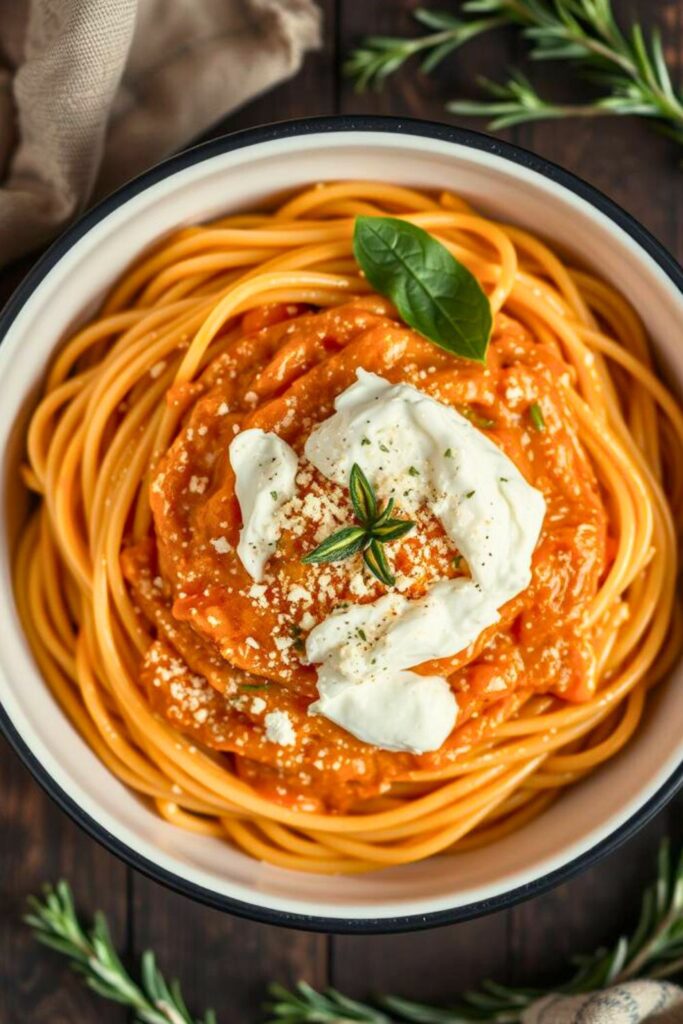
Understanding Emulsification Magic
We’re creating an emulsion here, that smooth blending of fat and water that makes restaurant sauces irresistible. Pasta starch acts as natural emulsifier, preventing separation while adding body.
Finishing pasta in its sauce allows noodles to absorb flavors while releasing more starch. That’s why restaurant pasta always tastes more integrated than sauce spooned over noodles.
Temperature control with burrata is crucial.
Hot pasta melts it completely. Warm pasta (what we want) keeps it creamy but intact.
Roasted red peppers contain natural sugars that caramelize during cooking. This creates complexity beyond simple sweetness, it’s why this sauce tastes so sophisticated.
Essential Tools for Success
A quality blender or food processor is non negotiable. I’ve tried mashing peppers with forks, the texture never comes together properly.
Wide, shallow pasta pots beat tall, narrow ones every time. More surface area means faster boiling and more even cooking.
Large skillets with sloped sides give you room to toss everything together without decorating your stovetop.
Presentation Tips for Restaurant Style Results
Plating Like a Professional
Warm your bowls first, hot water for sixty seconds, then dry thoroughly. Warm plates prevent burrata from firming up too quickly.
Twirl pasta high in bowl centers.
Top with remaining burrata chunks and generous Parmesan sprinkles. Fresh basil leaves scattered on top add color and final herb brightness.
Good olive oil drizzled around plate edges plus fresh black pepper cracks create professional polish without fussiness.
Perfect Pairings for Your Creamy Red Pepper Pasta with Burrata and Herbs
Crisp white wines cut through richness superbly, try Pinot Grigio or Sauvignon Blanc. Red wine lovers should go light with Chianti Classico that won’t overpower delicate flavors.
Keep sides simple.
Bitter green salads with lemon vinaigrette provide perfect contrast. Quality bread soaks up escaped sauce deliciously.
For complete Italian experience, start with light antipasto, olives, salami, marinated vegetables. Nothing too heavy that competes with your pasta.
Advanced Variations for Your Creamy Red Pepper Pasta Creation
Creative Additions That Work
Once you’ve mastered the basic technique, customization becomes fun.
Roasted cherry tomatoes add sweetness and color. Spinach wilted in provides nutrition and vibrant green contrast.
Toasted pine nuts create wonderful textural variety. Italian sausage turns this into heartier fare.
Sun dried tomatoes intensify the Mediterranean flavors.
Professional Tips for Consistent Results
Don’t fear thick looking sauce initially. It thins perfectly when pasta water gets added.
Better to start thick than watery.
Burrata melts faster than you expect. Have everything ready before adding it. Once it goes in, you’re committed to immediate serving.
Taste constantly.
Every pepper jar differs slightly, every Parmesan block varies in saltiness. Your palate guides you best.
This dish reheats adequately with cream splashes, but truly shines when served fresh with creamy burrata and bright herbs intact.
Troubleshooting Your Creamy Red Pepper Pasta with Burrata and Herbs
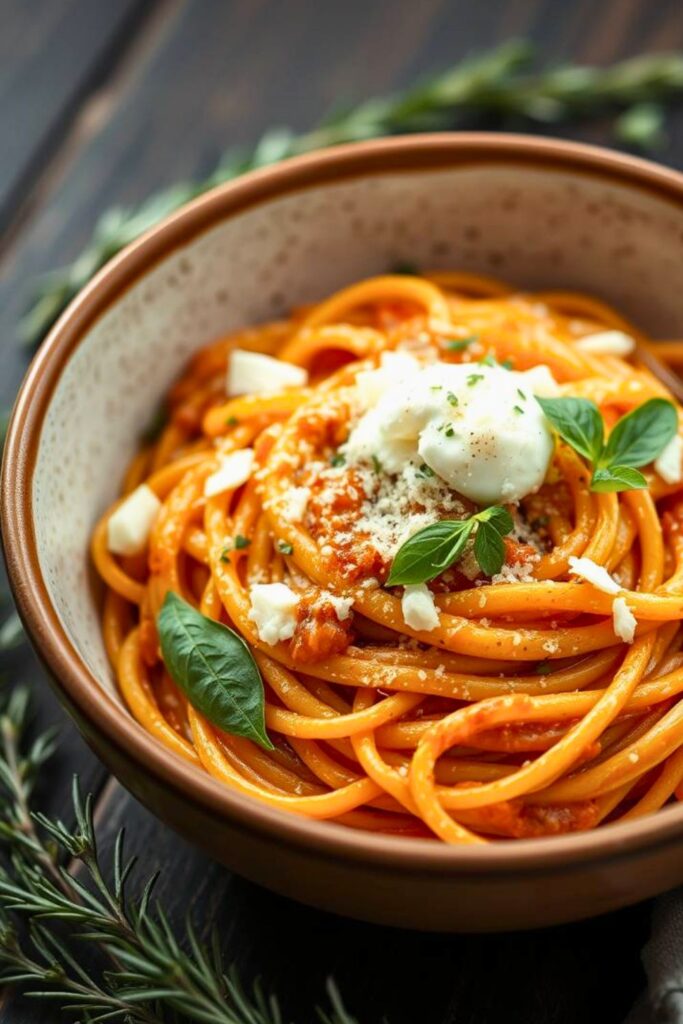
Common Problems and Quick Solutions
Sauce breaking or looking curdled happens when heat runs too high or cream gets added too fast.
Remove from heat immediately and whisk in cold pasta water tablespoon by tablespoon. Still broken? Transfer everything to blender and pulse briefly.
Pasta seems dry? Add more reserved pasta water gradually while tossing. That starchy water is magic for sauce consistency.
Flavors taste flat? You probably need more salt.
Pasta dishes require generous seasoning to taste properly balanced.
Burrata disappeared completely? Next time, add it to slightly cooler pasta and toss more gently. Temperature control is everything with fresh cheese.
Frequently Asked Questions
Can I prepare this sauce ahead?
Absolutely! The red pepper base can be made in advance and keeps beautifully in the refrigerator for up to three days. When you’re ready to serve, gently reheat the sauce on low heat to preserve its vibrant flavor, then stir in the cream just before tossing with pasta.
As for the burrata, always add it fresh at serving time—reheating changes its delicate, creamy texture and takes away the luxurious contrast it brings to the dish. Preparing ahead this way actually makes mealtime feel effortless while keeping every bite just as indulgent.
What fixes broken or curdled sauce?
Remove from heat immediately and begin whisking in cold pasta water, one tablespoon at a time. This helps the sauce regain its silky smooth consistency without breaking.
If that doesn’t fully fix it, don’t worry—transfer the mixture to a blender and pulse briefly until everything comes back together in a splendidly creamy, cohesive sauce. It’s a quick save with delicious results.
Always reserve the burrata for serving time. Reheating causes it to lose that luxurious, creamy texture and delicate flavor that makes it shine atop your freshly plated pasta.
Which pasta shapes work best?
Shapes that hold sauce work brilliantly—think rigatoni, penne, shells, or even pillowy gnocchi. Their ridges and curves catch every drop of that creamy red pepper richness, making each bite extra satisfying. Long pasta like fettuccine or linguine works too, though they need just a touch more sauce to ensure a silky, even coating that clings to every strand. Either way, the result is pure comfort in a bowl.
How should I store leftovers?
Refrigerate covered for up to two days to maintain quality. When ready to enjoy again, reheat slowly with a few splashes of cream or milk to revive the sauce’s richness. Use the microwave on medium power, stirring every thirty seconds to ensure even warming without drying it out. The texture may soften compared to the freshly made version, but the deep, comforting flavor still shines through beautifully.
What’s the best fresh red pepper charring method?
Char directly over a gas flame or beneath the broiler, rotating until the pepper’s skin is deeply blistered and blackened all over. This intense charring creates the smoky depth that defines roasted peppers. After that, transfer them to a bowl and cover tightly to steam for about ten minutes—this softens the skin and makes peeling easier. When peeling, avoid rinsing under water, no matter how tempting—it washes away those rich, smoky flavor compounds you worked hard to create. Instead, gently peel the skin with your hands, and for any stubborn bits, use the flat edge of a knife to scrape them off carefully.

Swiftly Captions by Tina Smith — Quick, flavorful food recipes made simple, bringing fresh inspiration to your kitchen every day
